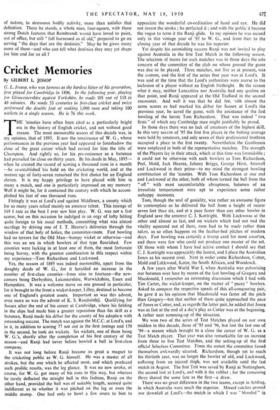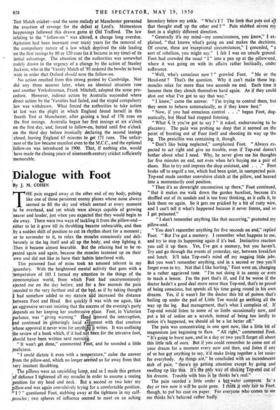Cricket Memories
By GILBERT L. JESSOP G. L. Jessop, who was famous as the hardest hitter of his generation, first played for Cambridge in 1896. In the following year, playing for Gloucestershire against Yorkshire, he made 101 out of 118 in 40 minutes. He made 53 centuries in first-class cricket and twice performed the double feat of making 1,000 runs and taking 100 wickets in single season. He is 76 this week. THE 'nineties have often been cited as a particularly bright era in the history of English cricket, and not without good reason. The most memorable season of this decade. was, in my opinion, that of 1895. It saw the renaissance of W. G , whose performances in the previous year had appeared to foreshadow the close of the great career which had earned for him the title of Champion. And rightly so, for his pre-eminence as a batsman had prevailed for close on thirty years. By his deeds in May, 1895— when he created the record of scoring a thousand runs in a month —he re-established-his hold on the cricketing world, and at the mature age of forty-seven remained the first choice for an England eleven. It is my happy privilege to have played with him in many a match, and one is particularly impressed on my memory Well it might be, for it contained the century with which he accom- plished his feat of one thousand runs.
Fittingly it was at Lord's and against Middlesex, a county which for so many years relied mainly on amateur talent. This innings of 169 I rate' as the best I ever saw him play. W. G. was not a fast scorer, but on this occasion he indulged in an orgy of lofty hitting quite foreign to his usual methods, committing what was almost sacrilege by driving one of J. T. Hearne's deliveries through the window of that holy of holies, the committee-room. Fast bowling had no terrors for the Old Man—bumpy wicket or otherwise—and this was an era in which bowlers of that type flourished. Few counties were lacking in at least one of them, the most fortunate being Surrey, with the greatest combination in this respect within my experience—Tom Richardson and Lockwood.
Yes, the season of 1895 was indeed memorable, apart from the doughty deeds of W. G., for it heralded . an increase in the number of first-class counties—from nine to fourteen—the new- comers being Derbyshire, Leicestershire, Warwickshire, Essex and Hampshire. It was a welcome move on one ground in particular, for it brought to the front a wicket-keeper, Lilley, destined to become one of England's greatest assets. Important as was thi' advent, even more so was the advent of K. S. Ranjitsinhji. Qualifying for Sussex after the end of his career at Cambridge, where his fielding in the slips had made him a greater reputation than his skill as a batsman, Ranji made his debut for the county of his adopticn with astounding success. The match was against the M.C.C. at Lord's, and in it, in addition to scorini 77 not out in the first innings and 150 in the second, he took six wickets. Six wickets, one of them being W. G.'s, shortly after the completion of his first century of the season—and Ranji had 'never before bowled a ball in first-class company.
It was not long before Ranji became as great a magnet to the cricketing public as W. G. himself. He was a master of all strokes, but the one which he affected most, and which produced such prolific results, was the leg glance. It was no new stroke, of course, for W. G. got many of his runs in this way, but whereas he rarely deflected the straight ball in this fashion, Ranji on the other hand, provided the ball was of suitable length, seemed quite indifferent as to whether it was pitched on the leg or even the middle stump. One had only to bowl .a few overs to him to appreciate the wonderful co-ordination of hand and eye. He did not invent the stroke ; he perfected it ; and with the public it became the vogue to term it the Ranji glide. In my opinion he was second only in this vintage year of '95 to W. G., and from then to the closing year of that decade he was his superior.
Yet despite his astonishing success Ranji was not invited to play against Australia in the first Test Match in the following season.
The selection of teams for such matches was in those days the sole concern of the committee of the club on whose ground the game was due to be played. Three matches, not five as at present, was the custom, and the first of the series that year was at Lord's. It was said at the time that the Lord's authorities were averse to the inclusion of a player without an English birthright. Be the reason what it may, neither Lancashire nor Australia had any qualms oa that point, and Ranji appeared at the Old Trafford in the second encounter. And well it was that he did, for, with almost the same scores as had marked his debut for Sussex at Lord's the previous year, he saved the game, with the assistance of the fast bowling of the heroic Tom Richardson. That was indeed " two firsts " of which any Cambridge man might justifiably be proud.
In those days there was no lack of amateurs of the highest skill. In this very season of '95 the first five places in the batting average were held by amateurs, and only seven of their professional brethren , occupied a place in the first twenty. Nevertheless the Gentlemen were outplayed in both of the representative matches. The strength of the Players lay in their attack, which at this time was formidable ; it could not be otherwise with such bowlers as Tom Richardson, Peel, Mold, Jack Hearne, Johnny Briggs, George Hirst, Attewell and Lockwood in their prime—to my mind the strongest bowling combination of the 'nineties. With Tom Richardson at one end and Lockwood at the other, both of whom turned the ball from the " off " with most uncomfortable abruptness, batsmen of an irresolute temperament were apt to experience some rather unhappy moments.
Tom, though the soul of geniality, was rather an awesome figure to contemplate as he delivered the ball from a height of nearer seven feet thaa six, and at a pace faster than any other bowler in England save the amateur C. J. Kortright. With Lockwoou at the other end almost as fast, and on wickets which had not had the vitality squeezed out of them, runs had to be made rather than taken, as so often happens on the feather-bed pitches of modern days. Fast bowling was certainly a trump card for most counties, and there were few who could not produce one master of the art. Of those with whom I have had active contact I should say that C. J. Kortright was appreciably the fastest, and I place the Australian Jones as his nearest rival. Next in order come Richardson, Cotter, Mold and Lotkwood, Kotze, the South African, and Woodcock.
A few years after World War I, when Australia was pulverising our batsmen over here by means of the fast bowling of Gregory and Macdonald, I remember an interesting discussion which I had with Tim Carter, the wicket-keeper, on the matter of " pacey " bowlers. Asked to compare the respective speeds of this all-conquering pair, he gave it as his opinion that Macdonald was faster off the pitch than Gregory—but that neither of them quite approached the pace of Jones or Cotter, and, as regards the latter pair, he added that Jones was as fast at the end of a day's play as Cotter was at the beginning. A rather neat summing-up of the situation.
We won two of the series of Test Matches played on our own midden in this decade, those of '93 and '96, but lost the last one of '99—a season which brought to a close the career of W. G. as a Test Match player. That year was also remarkable for an increase from three to five Test Matches, and -the setting-up of the first official Selection Committee. From the outset the committee found themselves awkwardly situated. Richardson, though yet to reach his thirtieth year, was no longer the bowler of old, and Lockwood, suffering from an injured thigh,' was not available until the last match in. August. The first Test was saved by Ranji at Nottingham, the second lost at Lord's, and with it the rubber ; for the remaining three shared the same fate as the first—a draw.
There was no great difference in the two teams, except in fielding, in which Australia were much the superior. Missed catches proved our downfall at Lord's=the Ertatch in which I was " blooded" iq
Test Match cricket—and the same malady at Manchester prevented the exaction of revenge for the defeat at Lord's. Momentous happenings followed this drawn game at Old Trafford. The law relating to the " follow-on " was altered, it change long overdue. 'Agitation had been incessant over many years for the removal of the compulsory nature of a law which deprived the side leading on the first innings by 80 or 120 runs (as it became in my time) of its initial advantage. The attention of the authorities was somewhat rudely drawn to the urgency of a change by the action of Stanley Jackson, who in the 'Varsity Match of '93 ordered the bowler to bowl wide in order that Oxford should save the follow-on.
No action resulted from this strong protest by Cambridge. Nor did any three seasons later, when an identical situation rose and another Yorkshireman, Frank Mitchell, adopted the same pro- cedure. However, indirect action by Australia succeeded where direct action by the 'Varsities had failed, and the stupid compulsory law was withdrawn. What forced the authorities to take action at last was the plight in which England found herself in this fourth Test at Manchester, after gaining a lead of 176 runs on the first innings. Australia began her first innings at six o'clock on the first day, and, forced to follow-on, batted until five o'clock ,on the third day before ironically declaring the second innings !closed, leaving England 65 minutes to get 171 runs. The unfair- ness of the law became manifest even to the M.C.C., and the optional follow-on was introduced in 1900. That, if nothing else, would have made the closing years of nineteenth-century cricket sufficiently 'memorable.











































 Previous page
Previous page